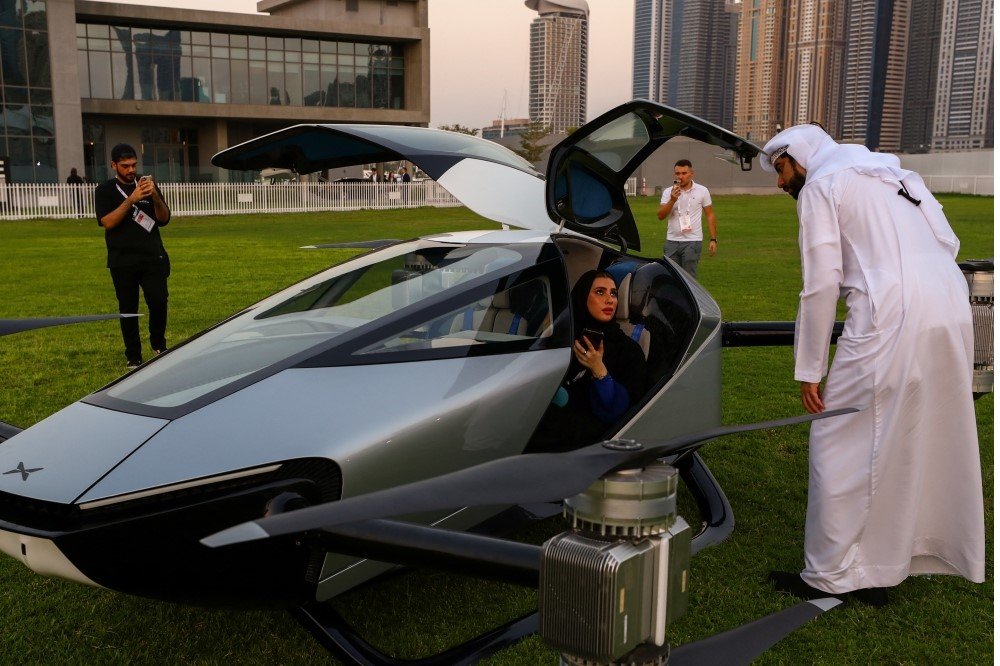How to Prepare for the Future of Flying Taxis in 2023

The concept of flying taxis, once relegated to the realm of science fiction, has rapidly become a tangible reality in 2023. With advancements in technology and the emergence of innovative transportation solutions, flying taxis are poised to transform urban mobility as we know it. This article delves into the exciting world of flying taxis, highlighting how individuals can prepare for this transformative mode of transportation.
As urban congestion reaches unprecedented levels, the idea of flying taxis has captured the imagination of urban planners, tech enthusiasts, and travelers alike. The prospect of bypassing traffic and reaching destinations swiftly through the air is no longer a distant dream.
The Rise of Flying Taxis
The year 2023 has witnessed significant milestones in the development of flying taxis. Companies like Uber, Volocopter, and EHang have made substantial progress in designing and testing these aerial vehicles. The convergence of electric propulsion, autonomous technology, and advanced materials has paved the way for these vertical takeoff and landing (VTOL) aircraft.
Advantages of Flying Taxis
Flying taxis offer a plethora of advantages. They promise reduced travel times, decreased congestion, and enhanced connectivity. Commuters can hop from one rooftop landing pad to another, skipping hours of road travel.
Infrastructure Development

The integration of flying taxis into urban landscapes necessitates the creation of vertiports and helipads. Urban planners are collaborating with architects to design these structures, which will serve as takeoff, landing, and service points for flying taxis.
Regulation and Safety Measures
Ensuring the safety of passengers and pedestrians is paramount. Regulatory bodies are working closely with manufacturers to establish air traffic management protocols, vehicle certification standards, and pilot training requirements.
Choosing Your Flying Taxi Service
With several companies entering the market, consumers will have choices. Factors such as vehicle design, service coverage, and pricing will influence one’s selection of a flying taxi provider.
Navigating Air Traffic
Air traffic management systems will play a crucial role in preventing collisions and ensuring smooth operations. These systems will monitor the airspace, guide flying taxis, and manage routes to avoid congestion.
Booking and Payment Systems
Booking a flying taxi will likely be as simple as using a ride-sharing app. Seamless payment systems will be integrated, allowing for hassle-free transactions.
The Flying Taxi Experience
The passenger experience will be redefined. Comfort, safety, and panoramic views will characterize the journey, making it an adventure in itself.
Environmental Considerations
Electric propulsion systems and sustainable materials will contribute to reducing the environmental footprint of flying taxis. This aligns with the growing demand for eco-friendly transportation solutions.
Addressing Challenges
While the potential is immense, challenges include noise pollution, integration with existing transport networks, and public acceptance. Overcoming these hurdles will be crucial for widespread adoption.
Integration with Public Transport
To maximize efficiency, flying taxis need to seamlessly integrate with existing modes of public transportation, creating a holistic urban mobility ecosystem.
Economic Impact
The introduction of flying taxis will stimulate economic growth by creating jobs in manufacturing, maintenance, and operations. Additionally, it could lead to increased tourism and business opportunities.
Global Adoption and Future Prospects
While flying taxis are making waves in developed countries, their impact could be even more transformative in regions with limited infrastructure. The future holds the potential for aerial mobility to reshape how we think about travel.
Technological Advancements Shaping Global Adoption
The Role of Artificial Intelligence
Artificial Intelligence (AI) has transcended its initial boundaries and is now an integral part of various industries. From predictive analytics to natural language processing, AI-driven solutions are enhancing efficiency, decision-making, and customer experiences. The global business landscape is adopting AI-driven insights to optimize operations and personalize user interactions.
IoT and Its Impact on Connectivity
The Internet of Things (IoT) is fostering unprecedented connectivity between devices and systems. This interconnectedness is not only streamlining processes but also creating new possibilities for data-driven insights. With IoT-enabled devices becoming commonplace in homes, businesses, and cities, the global adoption of this technology is undeniable.
Blockchain Revolutionizing Transactions
Blockchain technology has disrupted traditional transaction systems. Its decentralized and secure nature is gaining traction across industries, especially in finance and supply chain management. The transparency and immutability of blockchain are revolutionizing global transactions, reducing fraud, and increasing trust between parties.
E-Commerce

The Convenience of Online Shopping
E-commerce has evolved into a global marketplace, enabling consumers to shop for products and services from around the world with ease. The convenience of browsing and purchasing online has reshaped consumer behavior and retail trends.
Cross-Border Transactions and Payment Gateways
E-commerce’s global adoption is further supported by cross-border payment gateways. These systems facilitate secure and seamless transactions across different currencies, making international shopping more accessible than ever before.
The Rise of M-Commerce
Mobile commerce (M-commerce) is a driving force behind global e-commerce adoption. With smartphones becoming ubiquitous, consumers can shop on the go, leading to an exponential growth in mobile transactions.
Education Goes Global Through E-Learning
Accessibility to Quality Education
E-learning has democratized education by making quality learning resources available to individuals worldwide. Online courses, webinars, and virtual classrooms have broken down geographical barriers, allowing anyone with an internet connection to access valuable knowledge.
Learning Management Systems Transforming Academics
Learning Management Systems (LMS) have revolutionized the education landscape. Educators can create, manage, and deliver courses online, fostering interactive and engaging learning experiences.
Virtual Reality Enhancing Learning Experiences
Virtual Reality (VR) is adding a new dimension to global education. With VR simulations and immersive content, students can explore subjects in unprecedented ways, making learning more engaging and memorable.
Telemedicine
Overcoming Geographical Barriers
Telemedicine is transcending borders to provide healthcare services remotely. Patients can consult with doctors and specialists regardless of their location, reducing the need for travel and enhancing medical access.
Remote Consultations and Diagnostics
Through telemedicine, patients can receive remote consultations and even undergo diagnostic tests without visiting a physical clinic. This advancement is especially critical in areas with limited medical facilities.
AI-Driven Healthcare Solutions
Artificial Intelligence is playing a pivotal role in diagnosing diseases and predicting health trends. AI-driven algorithms analyze medical data to assist healthcare professionals in making accurate and timely decisions.
Sustainable Energy and Environmental Awareness
Embracing Renewable Energy Sources
The global shift toward renewable energy sources is crucial for environmental sustainability. Solar, wind, and hydropower technologies are being adopted worldwide to reduce carbon footprints and dependence on fossil fuels.
IoT for Smart Energy Management
The Internet of Things is optimizing energy consumption through smart devices and systems. IoT-enabled sensors and controls are enhancing energy efficiency in homes, industries, and cities.
Promoting Green Initiatives Worldwide
Environmental awareness is driving global efforts to adopt eco-friendly practices. Governments, businesses, and individuals are actively participating in initiatives to conserve resources, reduce pollution, and promote sustainable living.
Future Prospects
The momentum of global adoption shows no signs of slowing down as we step into 2023. Here are some exciting prospects for the future:
Continued Technological Innovations
Innovation will remain a driving force, with breakthroughs in AI, quantum computing, and biotechnology shaping various industries.
Integration of AI in Daily Life
AI-powered devices and services will seamlessly integrate into our daily routines, from personalized virtual assistants to smart homes.
Evolving Workplace Dynamics
Remote work and hybrid models will redefine the traditional workplace, offering flexibility and opening doors to a global talent pool.
The Need for Stronger Cybersecurity Measures
As technology advances, so do cyber threats. Robust cybersecurity measures will be essential to protect sensitive data and digital infrastructure.
Environmental Sustainability as a Priority

The global community will prioritize sustainable practices, from renewable energy adoption to circular economy initiatives.
Conclusion
The era of flying taxis is on the horizon, and individuals can prepare for this exciting development by staying informed about the latest advancements, understanding the benefits and challenges, and considering how this mode of transportation fits into their daily lives.
Read more : Best 20 Budget-Friendly Countries to Visit in the World 2023
FAQs
Are flying taxis safe?
Flying taxis undergo rigorous testing and adhere to strict safety regulations to ensure passenger safety.
How much will a flying taxi ride cost?
Pricing models will vary, but competitive rates are expected, aiming to make flying taxis accessible to a wide range of travelers.
Do I need a pilot’s license to ride in a flying taxi?
No, flying taxis will be autonomous, eliminating the need for passengers to possess pilot skills.
Will flying taxis operate in rural areas?
Initially, the focus will be on urban areas, but as technology advances, rural connectivity could also be explored.
Can flying taxis be hailed on-demand?
Yes, similar to ride-sharing services, users will be able to book flying taxis on-demand through dedicated apps.
Read more : How to Harness the Potential of Fusion Energy in 2023








2 Comments